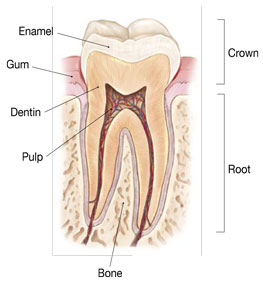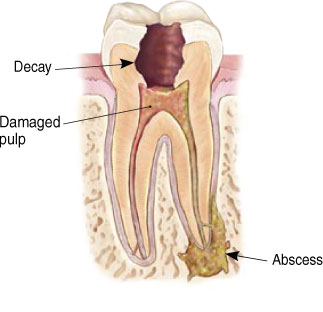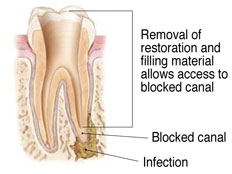What is Endodontics?
Endodontics is a branch of dentistry recognized by the American Dental Association dealing with treatment of the tooth, dental pulp and surrounding tissues.
When you look at your tooth in the mirror, what you see is the crown. The rest of the tooth, the portion hidden beneath the gum line, is the root. The outer portion of the root is a hard tissue called dentin. The inside channel, or root canal, contains the pulp, a soft tissue consisting of blood vessels, connective tissue and nerves. The pulp extends from the tip of the root(s) to the crown, and is an important component in the tooth’s growth and development. When the tooth becomes fully mature, the pulp can be successfully removed and the tooth will continue to be nourished by the surrounding tissues.

Bacteria introduced into the pulp because of tooth decay, periodontal disease, or a fracture can cause inflammation or infection, possibly resulting in pain and swelling. Damage to the pulp may also occur even if the tooth has no visible deterioration.
A root canal is treated to save the tooth and prevent further problems. After successful therapy, your general dentist will restore the tooth to normal function.

What Causes Endodontic Problems?
Root canal treatment becomes necessary when the pulp becomes inflamed or infected. Usually due to a deep cavity, trauma to the tooth or extensive restorative treatment. The signs of pulpal damage can include pain, sensitivity to hot or cold, color changes and swelling or soreness in the gums. Once the pulp becomes inflamed or infected, a root canal or extraction is necessary to remove the affected tissue and restore the area to health.
Treatment
Routine Non-Surgical
Most root canal procedures are non-surgical, and involve removing the injured pulp through the top surface of the tooth. After the removal of the infected tissue, a surgeon cleanses and shapes the root canal system to remove all traces of tissue and bacteria.
Then, a sterile, inert material seals the root canal system in order to prevent reinfection. After the root canal procedure is completed, you will be directed to return to your restorative dentist for a permanent filling or crown. Please avoid using the damaged tooth to chew until a permanent restoration is placed.
Microscopic Endodontics
At West Valley Endodontics, we take every reasonable step to remain at the forefront of our profession. Among other advanced techniques and instruments utilized by our group, surgical loupes with fiber optic illumination, and the surgical operating microscope have opened up entirely new vistas for the treatment of both non-surgical and surgical endodontics. Due to the enhanced illumination and high magnification optics, calcified canals can be optimally located. Additional, retreatment of endodontic cases that have failed due to separated , separated posts, and repair of perforations can now be managed with greater efficiency and success. These cases, in the past, could be managed only by surgical approaches that had a lower success rate.
In those cases in which surgical endodontics is the treatment of choice, the increased magnification and illumination provided allows for enhanced visualization of the surgical field. This, in turn, allows for more efficient surgical technique and greater ability to achieve success in surgical endodontics.
Retreatment
Sometimes it is necessary to “retreat” or “revise” a root canal because of infection after initial treatment. Complicated canal anatomy, contamination with oral bacteria as a result of a leaking restoration, and incomplete prior root canal therapy cause the majority of cases of reinfection.
Our team is experienced in root canal retreatment procedures, and can predictively return your tooth and surrounding tissues to health. Our experienced team has performed thousands of root canal retreatment procedures and specialize in restoring your tooth and its surrounding tissues to health.
After an initial examination using 2D digital and 3D computed tomography, we will explore and explain potential treatment options. Then we will remove the previous root canal filling materials and carefully re-clean the canals using a special operating microscope along with digital radiography. Once your tooth has been cleaned and shaped, we will place filling materials into the canals to seal the root canal system. The clinical success of an endodontic retreatment depends on many factors, including whether alterations in the natural course of the root canals were caused by previous root-canal treatment. Postoperatively, your restorative dentist will place a new restoration or repair your current restoration. Possible complications from this procedure are similar to those in the original endodontic procedure, however, the success rate for revision procedures is generally slightly lower

